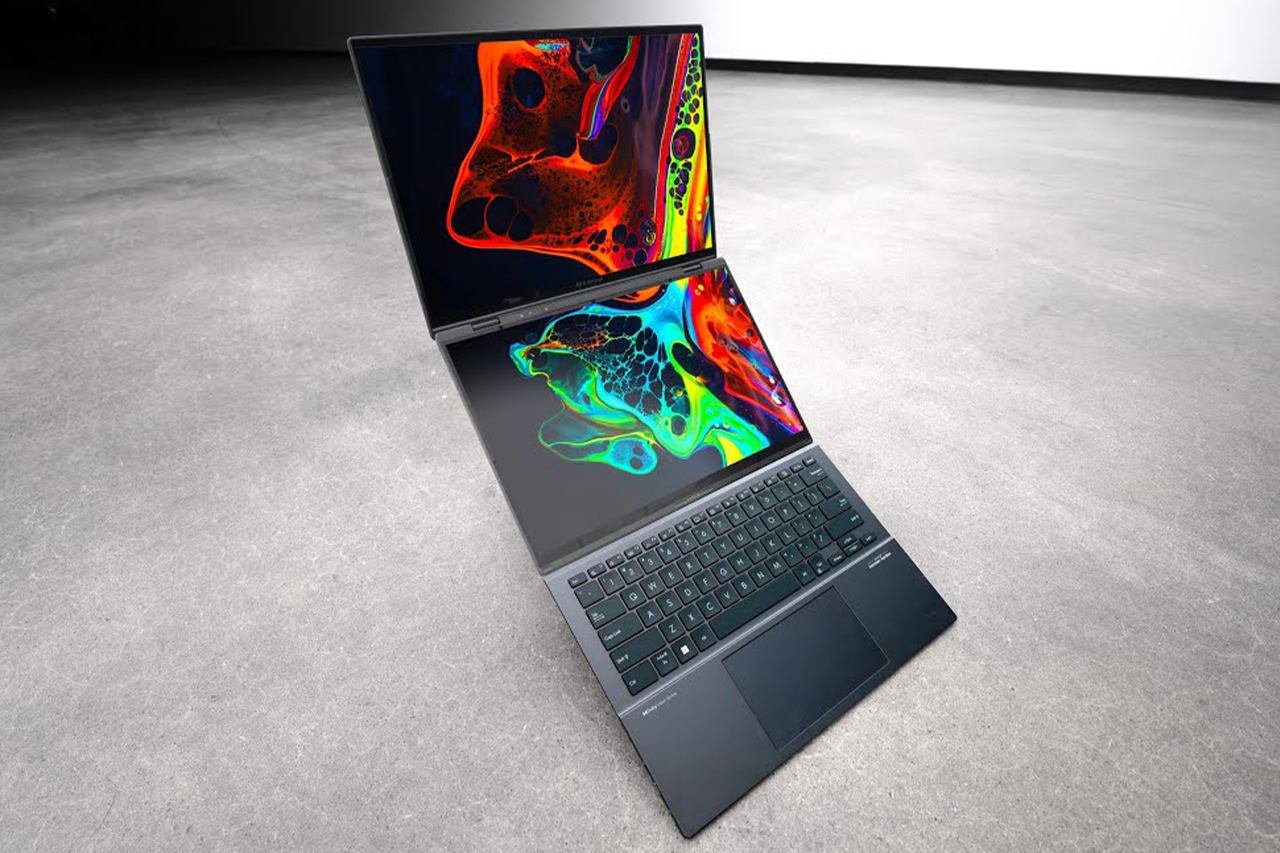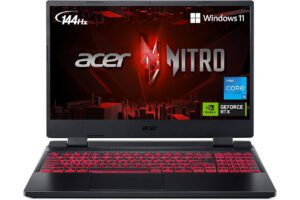
ASUS Zenbook DUO (UX8406) — Portable Dual-Screen OLED Powerhouse
Our take: the best portable dual-screen laptop—dual 14″ 3K 120Hz OLED, Ultra 9 power, 32GB/1TB, Wi-Fi 7 and smart desktop modes.
- Dual 14″ 3K 120Hz OLED touch; Pantone-validated 100% DCI-P3
- Intel Core Ultra 9 285H with Intel Arc graphics and NPU
- 32GB LPDDR5x + 1TB PCIe 4.0 SSD for instant multitasking
- Detachable magnetic Bluetooth keyboard and sturdy kickstand
- 75Wh battery: up to 16h single-screen, 9h dual-screen use
- Wi-Fi 7, TB4, HDMI 2.1 (TMDS) and USB-A in a 3.64 lb chassis
- Displays
- 2× 14″ 2880×1800 OLED, 120Hz
- Processor
- Intel Core Ultra 9 285H
- Graphics
- Intel Arc (integrated)
- Memory
- 32GB LPDDR5x
- Storage
- 1TB PCIe 4.0 SSD
- Battery
- 75Wh, fast charge
- Weight
- 3.64 lb (0.57″ thin)
- Ports
- 2× TB4, USB-A, HDMI 2.1 TMDS, 3.5mm
- Wireless
- Wi-Fi 7, Bluetooth 5.4
- Extras
- ASUS Pen 2.0 & Sleeve
The ASUS Zenbook DUO isn’t a “novelty dual-screen.” It’s a serious, portable workstation that just happens to fold open into two gorgeous 14-inch OLED touch panels. Think of it as an ultraportable that can become a stacked dual-monitor desk anywhere—coffee shop, airplane tray, hotel nightstand.
This 2024 redesign (UX8406 series, Ultra 9 285H configuration tested) pairs Intel’s latest Core Ultra platform—with its integrated Arc graphics and on-chip NPU for AI acceleration—with a smart magnetic Bluetooth keyboard and a built-in kickstand. The hardware snaps together with the assurance you expect from ASUS’s premium Zenbook line.
If you live in spreadsheets, timelines, code editors, or you just like to keep reference docs, Slack/Teams, and playlists visible while you work, this machine lands in a sweet spot. It’s premium, undeniably different, and engineered for people who value flow over fiddling.
Is the ASUS Zenbook DUO for you?
The Zenbook DUO solves a problem commuters and creators know too well: the productivity tax of a single display. With two 14-inch 3K OLED touchscreens, it gives you vertical real estate like a stacked dual-monitor rig, minus the desk. Laptop Mode keeps things familiar; flip the kickstand and detach the keyboard, and Desktop or Dual-Screen Mode turns it into a compact command center.
It’s for multitaskers, remote pros, creatives, developers, analysts, and students who juggle windows all day. Editors can run a timeline on the lower panel and a full-screen preview above. Developers can code up top and keep a terminal or docs below. Writers can research on one screen while drafting on the other. Digital artists get pen-friendly glass with 120 Hz fluidity and true-black contrast.
It’s not for everyone. If you want a pure gaming rig with an RTX dGPU, this integrated Arc solution isn’t chasing 120 fps in modern AAA titles. If your workflow never needs a second screen, the DUO’s brilliance will be underutilized. If you demand all-day battery in dual-screen mode at 120 Hz, physics will push you to plug in more often.
Budget-wise, it sits in the premium tier. In return, you get cutting-edge screens, Intel’s modern platform, Wi-Fi 7, and a bundle that actually respects how you’ll use the device. Despite the advanced form factor, it remains beginner-friendly: Windows 11, a normal detachable keyboard/trackpad, and ASUS’s on-screen utilities make the modes straightforward.
What We Like About the ASUS Zenbook DUO
The OLEDs are the star. Dual 14-inch, 2880×1800, 120 Hz, 16:10 panels with punchy color (100% DCI-P3, Pantone-validated) and true blacks change how you structure your work. Stacking windows without bezels between them feels natural, and HDR pop with deep contrast gives images and video real depth. The 91% screen-to-body ratio keeps the chassis compact.
Versatility is the second win. ASUS nails the mechanics: a sturdy integrated kickstand, a magnetic Bluetooth keyboard that charges when docked, instant mode switching, and a hinge that stays put. Laptop Mode is ordinary in the best way; Dual-Screen Mode is extraordinary in the best way. Presentation and Sharing modes make collaboration clean: prop it up, lay it flat, mirror or extend, done.
Performance is exactly what a mobile pro needs. Intel Core Ultra 9 285H delivers high-end ultraportable CPU performance, quick media transcodes, and snappy multitasking with 32 GB of LPDDR5x memory and a speedy 1 TB PCIe 4.0 SSD. The integrated Intel Arc graphics are more capable than older integrated solutions and pair nicely with the dual 3K canvases for creation apps and light gaming.
The details round it out. There’s a FHD IR camera for Windows Hello, Wi-Fi 7 and Bluetooth 5.4 for modern connectivity, Dolby Atmos-tuned Harman/Kardon audio, and MIL-STD-810H durability. At 3.64 lb and just 0.57 in thick, it’s surprisingly travel-friendly for a dual-display rig. Battery management is sensible too: single-screen days stretch long, and dual-screen sessions still get respectable endurance given the hardware.
What We Don’t Like About the ASUS Zenbook DUO
Two 120 Hz OLEDs are demanding. If you leave both panels at max refresh and brightness, you’ll visit the charger more often than with a conventional ultrabook. ASUS’s power profiles and OLED care tools help, but dual-screen workflows do carry a battery tax.
The detachable keyboard is very good—but not everyone will love it. Docked, it feels like a conventional laptop. Detached, it’s accurate and responsive, yet the split between screen(s) and keyboard takes a couple of days to feel second nature, especially on cramped surfaces. The trackpad is fine, not amazing; many users will add a mouse for desk work.
Ports are thoughtful but not abundant. Two Thunderbolt 4 ports, one USB-A, HDMI 2.1 (TMDS), and a combo audio jack cover most needs, yet creators who live on SD cards or wired Ethernet will need dongles. That’s common in ultraportables, but still worth noting.
Finally, integrated Arc graphics are much stronger than yesterday’s iGPUs, but buyers with heavy CUDA-centric workflows or serious AAA gaming expectations should look to a dGPU system. The DUO is built for creation and multitasking first.
Pros & Cons
| Pros | Cons |
|---|---|
| Dual 14-inch 3K 120 Hz OLED touchscreens with excellent color and contrast | Battery drops faster in dual-screen, high-refresh workflows |
| Intelligent modes: Laptop, Dual-Screen, Desktop, Presentation/Sharing | Port selection is good, not expansive (no SD/Ethernet) |
| Detachable magnetic Bluetooth keyboard + sturdy kickstand | Learning curve when typing detached in tight spaces |
| Core Ultra 9 + 32 GB RAM + 1 TB PCIe 4.0 SSD = fast everyday and creator performance | Integrated Arc graphics aren’t for heavy AAA gaming/CUDA |
| Wi-Fi 7, TB4, Dolby Atmos audio, IR camera, MIL-STD durability | |
| 3.64 lb, 0.57″ thin: surprisingly portable for a dual-screen |
What’s Included?
- ASUS Zenbook DUO (UX8406CA-PS99T)
- Detachable full-size magnetic Bluetooth® keyboard (charges when attached)
- ASUS Pen 2.0 (SA203H) with Microsoft Pen Protocol 2.0 support
- 65 W USB-C power adapter and power cord
- Protective sleeve
- User guide / quick start materials
As bundles go, this one feels complete. The keyboard and pen are not nickel-and-dimed add-ons—they’re included, and they matter. The sleeve is practical for travel. An Ethernet or USB-C hub and spare pen nibs would have been nice touches, but the essentials are present, and you can hit the ground running.
Technical Specifications
| Category | Specification |
|---|---|
| Model | ASUS Zenbook DUO UX8406CA-PS99T (Style: Ultra 9 285H) |
| Processor | Intel® Core™ Ultra 9 285H (with Intel AI Boost NPU) |
| Graphics | Integrated Intel® Arc™ |
| Memory | 32 GB LPDDR5x |
| Storage | 1 TB PCIe® 4.0 SSD |
| Displays | Dual 14″ ASUS Lumina OLED touchscreens, 2880×1800 (3K), 16:10, 120 Hz, HDR peak up to ~500 nits, 100% DCI-P3, Pantone-validated |
| Cameras | FHD IR front camera (Windows Hello) |
| Audio | Dolby Atmos, Harman/Kardon-tuned speakers; mic array |
| Wireless | Wi-Fi 7, Bluetooth 5.4 |
| Ports | 2× Thunderbolt™ 4 (USB-C), 1× USB 3.2 Gen 1 Type-A, 1× HDMI® 2.1 (TMDS), 1× combo audio jack |
| Battery | 75 Wh; fast charge via USB-C; up to ~16 hrs (single screen video) / ~9 hrs (dual-screen video) |
| Dimensions | 12.34″ × 8.58″ × 0.57–0.78″ |
| Weight | 3.64 lb (device) |
| Build / Durability | MIL-STD-810H tested; Inkwell Gray finish |
| OS | Windows 11 Home |
| In-box Extras | Magnetic Bluetooth keyboard, ASUS Pen 2.0 (MPP 2.0), sleeve, 65 W USB-C charger |
Features
- Multi-Screen Versatility. Seamlessly switch between Laptop, Dual-Screen, Desktop, Presentation, and Sharing modes to match the task at hand.
- ASUS dual-screen software. Window snapping, task groups, and on-screen controls make arranging apps across two panels effortless.
- Dual 3K 120 Hz OLED touch panels. 16:10 aspect, deep blacks, vibrant color, and responsive touch/pen input on both screens.
- Core Ultra power with AI NPU. Fast day-to-day performance, efficient background AI effects, and accelerated creator workflows.
- Portability first. 3.64 lb and 0.57″ thin with a detachable keyboard and integrated kickstand—desk-like setups anywhere.
- All-day battery (single screen). 75 Wh pack with fast charging; sensible endurance options for dual-screen work.
- Modern connectivity. Wi-Fi 7, Bluetooth 5.4, two Thunderbolt 4 ports, HDMI 2.1 (TMDS), USB-A, and audio jack.
- Creator-ready experience. Dolby Atmos audio, Pantone-validated color, and a responsive pen for sketching, annotation, and edits.
- Privacy and security. FHD IR camera for quick Windows Hello logins.
- Rugged confidence. MIL-STD-810H testing for the bumps and jolts of real travel.
Opinion on the features: this is a rare case where the headline feature—two OLEDs—doesn’t come with awkward compromises. The keyboard is full-size and genuinely usable, the hinge/kickstand are robust, and the software support is mature. You get real creator-class displays without carrying external monitors or tablets, and the platform is modern enough to keep up with serious multitasking. The trade-offs (ports and battery under heavy dual-screen loads) are manageable with a small travel hub and a USB-C charger in your bag.
Real-World Use: Workflows That Shine
Writing & research. Top screen: clean writing canvas. Bottom screen: outlines, sources, style guide, and a live to-do list. The cognitive load of switching apps drops away; ideas flow faster when references are always in view.
Coding & documentation. Keep your IDE up top and a running terminal or logs below. Or split an API spec and browser preview. The vertical stack means neck-friendly scanning without side-to-side eye travel.
Photo & video. The lower panel makes a perfect timeline/palette space while previews pop on the upper OLED. The 120 Hz refresh helps with scrubbing, and true blacks deliver reliable contrast judgment.
Meetings & teaching. Run slides on one screen and speaker notes, chat, or OBS/studio controls on the other. Presentation and Sharing modes make impromptu walk-throughs painless.
Note-taking & annotation. With the ASUS Pen 2.0, you can jot quick diagrams or mark up PDFs on the lower display while the reference sits above. Latency feels snappy at 120 Hz, and palm rejection is dependable.
Travel & desks. On a plane, Laptop Mode avoids awkwardness. At a hotel, kickstand + detached keyboard equals a tidy mini-desk. At home, plug a single TB4 cable into a dock if you want peripherals; the DUO doesn’t force you into a permanent setup.
Display Quality and OLED Care
Both panels are a joy: crisp 3K at 14 inches, saturated yet accurate color, and the smoothness of 120 Hz. HDR pop hits nicely in supported content, and deep blacks make text look etched on glass. ASUS’s OLED care tools (pixel refresh, screen shift, and scheduling) are present; using app dark modes and varied content keeps things healthy.
Brightness is ample indoors. Outdoors you’ll still want shade, as with most glossy OLEDs. Touch response is excellent, and the digitizer tracks the ASUS Pen 2.0 with precision that feels natural for sketching and annotation.
Performance, Thermals, and Noise
Core Ultra 9 285H brings a big step up over last-gen mobile chips in this class, especially in mixed CPU/GPU tasks and efficiency. Everyday workloads—Chrome tab zoos, Office, Slack/Teams, Zoom, Lightroom, Audition—glide. The integrated Arc engine offloads media with modern codecs, and the NPU handles Windows Studio effects and other light AI tasks without leaning only on the CPU/GPU.
Under sustained dual-screen loads, the fans become audible but not obnoxious, and the chassis warms sensibly near the hinge where heat is expelled. ASUS’s performance profiles let you choose silence, balance, or sustained speed. In Balanced, it’s quiet for typical office use; in Performance, compiles and exports complete faster while remaining comfortable to the touch.
If your day is Blender cycles, Resolve with heavy noise reduction, or 3D rendering that wants CUDA, you’ll top out the platform sooner than on a dGPU workstation. For the DUO’s mission—mobile creation and relentless multitasking—the headroom is right.
Battery Life and Charging
ASUS quotes up to ~16 hours in Laptop Mode (single screen, video playback) and ~9 hours in Dual-Screen Mode. In mixed real-world work—Wi-Fi on, brightness around 60–70%, a blend of documents, browsing, calls, and media—you can expect long, uninterrupted sessions on the single screen and a respectable work block on dual screens before hunting for USB-C power.
Dual-screen work at 120 Hz is where you pay the most power tax. You can extend endurance by setting 60 Hz on the lower panel, using dark mode, or closing one display when you’re focused on a single task. Fast charge via TB4 is convenient; a compact GaN charger and power bank slide easily into the sleeve.
Keyboard, Trackpad, and Pen
Docked, the keyboard feels like a proper Zenbook deck with a comfortable layout and good key travel. Detached, it’s a solid Bluetooth board that instantly reconnects and charges when re-attached. The magnetic alignment is reassuring, and the deck flex is minimal.
The trackpad is accurate with Windows Precision gestures, though not the largest in class. For desk work, many users will prefer a mouse. ASUS Pen 2.0 is responsive and well-balanced, handy for scribbles and light sketching; for professional illustration you’ll still want a dedicated tablet, but for notes and markups it’s right on target.
Connectivity and Ports
You get two Thunderbolt 4 ports for power and fast I/O, one USB-A for legacy devices, HDMI 2.1 (TMDS) for straightforward display hookups, and a 3.5 mm combo jack.
Wi-Fi 7 support future-proofs your wireless life with lower latency and higher throughput on compatible routers. Bluetooth 5.4 improves stability with modern peripherals.
Creators may add a tiny TB4 hub for SD, Ethernet, and extra USB. The beauty of the DUO is that a single cable to a dock can give you desktop expandability whenever you’re at a fixed spot.
Software Experience
Windows 11 Home is familiar. ASUS’s additions—particularly the windowing helpers for dual-screen life—are actually useful.
You can create task groups that remember layouts, snap apps to either panel with a flick, and toggle refresh rates or power profiles quickly. The IR camera works with Windows Hello instantly; Dolby Atmos profiles fine-tune audio for calls or media.
Bloat is minimal on this premium model, and what’s there is easily tidied. Out of the box, you can be productive in minutes.
Durability, Serviceability, and Care
MIL-STD-810H testing gives confidence against bumps and travel abuse. The hinge and kickstand feel robust, and the finish resists fingerprints better than glossy alternatives.
As with most modern ultrabooks, user upgrades are limited; buy the RAM/storage configuration you plan to live with.
ASUS’s warranty and service network on Zenbooks is established, and OLED care tools help minimize long-term burn-in concerns.
Who Should Choose a Different Laptop?
- Hardcore gamers chasing high-refresh AAA titles on maximum settings.
- Compute-heavy 3D pros who rely on CUDA and expect workstation-class GPUs.
- Battery-first road warriors who run 12-hour days away from outlets while using two bright 120 Hz OLEDs nonstop.
- Peripheral power users who want built-in SD and Ethernet without carrying a compact hub.
If you see yourself above, consider a dedicated gaming or creator laptop with a discrete GPU, or a conventional ultrabook if you never use a second display.
Buying Tips and Setup Suggestions
- Tune refresh rates. Keep 120 Hz for the screen you’re directly interacting with and drop the other to 60 Hz when chasing battery life.
- Create task groups. Build presets for “Writing,” “Editing,” “Meetings,” and “Coding”—one click to entire layouts.
- Carry a tiny TB4 hub. Add SD, Ethernet, and extra USB without bulk.
- Use the pen intentionally. Mark up PDFs, storyboard, and annotate screenshots on the lower display while keeping references above.
- Practice the modes. After a week of swapping between Laptop, Desktop, and Presentation modes, the DUO feels like muscle memory.
Final Breakdown
| Preview | Product | Price | |
|---|---|---|---|
|
|
ASUS Zenbook DUO Laptop, Dual 14” OLED 3K 120Hz Touch Display, Evo, Intel Core Ultra 9 285H, Intel... | $1,799.99 $1,629.99 | Add to Cart |
9.2/10
The ASUS Zenbook DUO is the rare innovation that makes immediate sense: two superb 14-inch OLEDs, intelligently packaged, that travel like a laptop and work like a studio. ASUS backs the idea with the right parts—Core Ultra 9, fast storage, plenty of RAM, Wi-Fi 7—and the right accessories in the box. The software glue is mature enough that you’re arranging and saving window layouts instead of fighting them.
It’s not the machine for heavy RTX-class workloads or marathons of dual-screen brightness at 120 Hz without a plug. But if your productivity is defined by how many things you can see and act on at once, this is the best dual-screen execution you can buy today. It enables flow, reduces window shuffling, and makes small spaces feel like big desks.
Recommendation: Strongly recommended for creators, knowledge workers, coders, and students who benefit from true dual-screen mobility and value premium displays. If that describes your day, the Zenbook DUO will pay you back in focus and output almost immediately.






